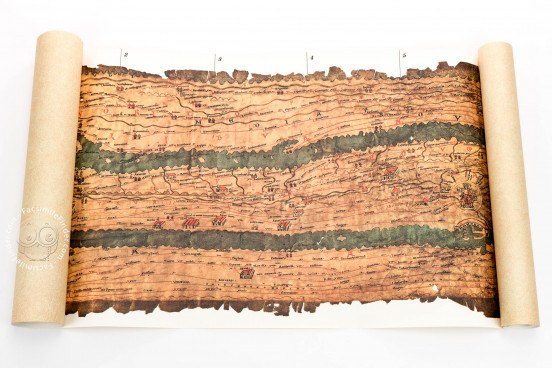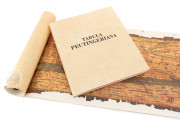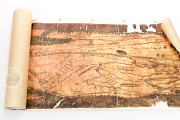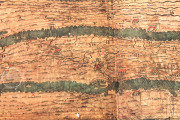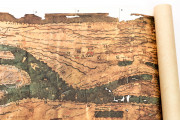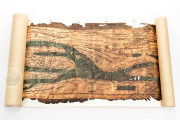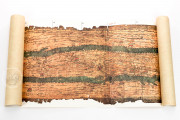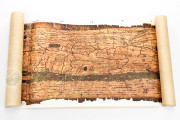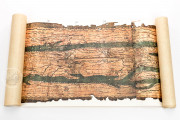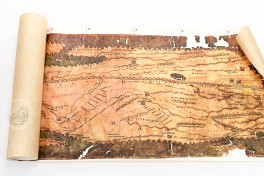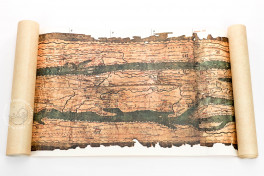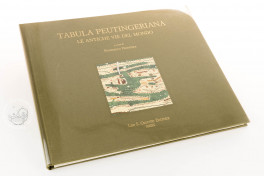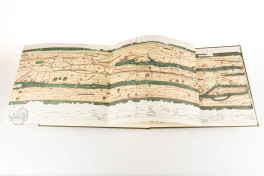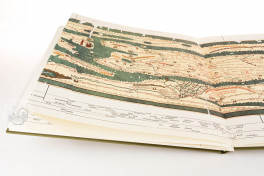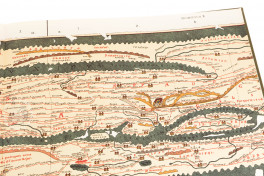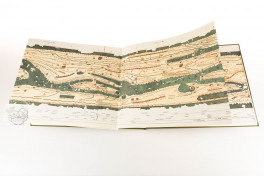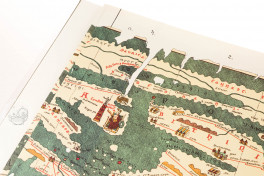The Peutinger Map, which shows the road network of the Roman Empire, is one of the most important documents in the history of cartography. Created ca. 1200 probably in greater Swabia (southern Germany) and based on an ancient Roman model, it is a fundamental tool for understanding and studying the known world during the Roman imperial period. It portrays, among other features, main roads, rivers, forests, and villages, covering originally an area from Sri Lanka in the Far East to the Atlantic. A part of the model—i.e., much of Britain, Spain, and the northwestern part of Africa—was missing at the time the copy was made, and the Peutinger Map reflects that lacuna.
One of the most remarkable features of the Peutinger Map is its format as a roll and its large size. It was composed of eleven segments of parchment, now separated. The chart contains abundant information on the inhabited world known to the ancient Greeks and Romans, including mountains, cities, harbors, baths, and temples.
A Pictorial Image of the Roman Empire
The distances on the map are recorded in Roman miles (1481 meters). The medieval mapmaker introduced Christian references, such as the Church of Saint Peter's in Rome and the site of the Mount of Olives.
Personifications of Major Cities
The most noteworthy feature of the map is perhaps the prominence given to the cities of Antioch, Constantinople, and Rome. Antioch is represented by an enthroned female personification and a bridge.
Constantinople appears as another enthroned woman, wearing a helmet and holding a shield. Near that figure is depicted a high tower surmounted by a statue, believed to represent Emperor Constantine the Great (d. 337).
The Importance of Rome
The city given the most prominence on the map is Rome. It is symbolized by a female figure holding a globe, a lance, and a shield, stressing the idea of Rome as caput mundi ("head of the world"). The figure is framed by a circle, from which a series of important Roman streets and roads emerge. The Tiber River, as well as the port of Ostia, are clearly depicted.
The whole map is crossed by a complex road network, which is thought to have been based in part on information gleaned from ancient textual sources listing distances. Thus, the Peutinger Map, although not topographically accurate, offers one of the most complete images of the road and transportation system of the Roman period.
A Map of Interest to Humanists
The Peutinger Map was discovered around 1500 by the German humanist Konrad Celtes (1459-1508), who gave it in 1507 to the antiquarian Konrad Peutinger (1465-1547), after whom it was named. Ignaz Desiderius Peutinger (1641-1718) sold the manuscript around 1714, and it was acquired by Eugene, Prince of Savoy (1663-1737), whose library was subsequently acquired by Charles VI (1685-1740), Holy Roman Emperor, for the Austrian Imperial Library, renamed the Österreichische Nationalbibliothek after World War II. The map was added to UNESCO's Memory of the World Register in 2007.
We have 3 facsimiles of the manuscript "Peutinger Map":
- Tabula Peutingeriana facsimile edition published by Edizioni Edison, 1978
- Tabula Peutingeriana. Le antiche vie del mondo facsimile edition published by Leo S. Olschki, 2009
- Tabula Peutingeriana facsimile edition published by Akademische Druck- u. Verlagsanstalt (ADEVA), 1976

